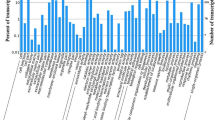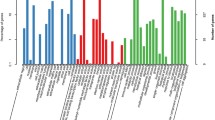Abstract
Anoplophora glabripennis (Motschulsky) has an advanced and complicated olfactory system to identify hosts, mates and spawning locations, and odorant-binding proteins (OBPs) play a key role by binding to volatile materials from different hosts. The full-length cDNA sequence of an OBP, AglaOBP, was cloned by RACE from an antenna cDNA library, and the protein structure and function were predicted by bioinformatics analysis. Gene temporal and spatial expression was detected by real-time qPCR. AglaOBP had distinctive sequence, location and expression profiles compared with other OBPs of A. glabripennis, as it was found in different tissues, and the highest expression was in the elytrums. The possible physiological functions of this OBP were discussed. These findings help elucidate the physiology of this pest and provide a new potential target for pest control.










Similar content being viewed by others
References
Calvello M, Brandazza A, Navarrini A et al (2005) Expression of odorant-binding proteins and chemosensory proteins in some Hymenoptera. Insect Biochem Mol Biol 35(4):297–307
Chen L, Li HL, Zhou YX et al (2013) cDNA cloning, tissue expression and ligand binding characteristics of odorant-binding protein 2 from the oriental fruit fly, Bactrocera dorsalis (Diptera: Tephritidae). Acta Entomol Sin 56(6):612–621
Cheng XJ, Cai LJ, Zheng LS et al (2016) Cloning, expression profiling and binding characterization of the OBP2 gene in the diamondback moth, Plutella xylostella (Lepidoptera: Plutellidae). Acta Entomol Sin 59(4):365–376
Danty E, Arnold G, Huet JC et al (1998) Separation, characterization and sexual heterogeneity of multiple putative odorant-binding proteins in the honeybee Apis mellifera L (Hymenoptera: Apidea). Chem Senses 23(1):83–91
Du G, Ng CS, Prestwich GD (1994) Odorant binding by a pheromone binding protein: active site mapping by photoaffinity labeling. Biochemistry 33(16):4812–4819
Forêt S, Maleszka R (2006) Function and evolution of a gene family encoding odorant binding-like proteins in a social insect, the honey bee (Apis mellifera). Genome Res 16(11):1404–1413
Haack RA, Herard F, Sun J et al (2010) Managing invasive populations of Asian longhorned beetle and citrus longhorned beetle: a worldwide perspective. Annu Rev Entomol 55:521–546
Ji T, Shen F, Liang Q et al (2014) Cloning, prokaryotic expression and tissue expression profiling of an OBP3 gene in the Chinese honeybee, Apis cerana cerana (Hymenoptera: Apidae). Acta Entomol Sin 57(8):897–904
Ju Q, Li X, Jiang XJ et al (2014) Transcriptome and tissue log specific expression analysis of obp and csp genes in the dark black chafer. Arch Insect Biochem Physiol 87(4):177–200
Kruse SZR, Smith DP, Dnm J (2003) Structure of a specific alcohol-binding site defined by the odorant binding protein LUSH from Drosophila melanogaster. Nat Struct Biol 10(9):694–700
Li S, Picimbon JF, Ji S et al (2008) Multiple functions of an odorant-binding protein in the mosquito Aedes aegypti. Biochem Biophys Res Commun 372(3):464–468
Li ZQ, Zhang S, Luo JY et al (2013) Two minus-C odorant binding proteins from Helicoverpa armigera display higher ligand binding affinity at acidic pH than neutral pH. J Insect Physiol 59(3):263–272
Liu Y, Gu S, Zhang Y et al (2012) Candidate olfaction genes identified within the Helicoverpa armigera antennal transcriptome. PLoS ONE 7:e48260
Matsuo T, Sugaya S, Yasukawa J et al (2007) Odorant-binding proteins OBP57d and OBP57e affect taste perception and host-plant preference in Drosophila sechellia. PLoS Biol 5(5):e118
Mckenna DD, Scully ED, Pauchet Y et al (2016) Genome of the Asian longhorned beetle (Anoplophora glabripennis), a globally significant invasive species, reveals key functional and evolutionary innovations at the beetle–plant interface. Genome Biol 17(1):227
Pelosi P, Maida R (1995) Odorant-binding proteins in insects. Comp Biochem Physiol B Biochem Mol Biol 111(3):503–514
Ping H, Wang J, Cui M et al (2016) Antennal transcriptome analysis of the Asian longhorned beetle Anoplophora glabripennis. Sci Rep 6:26652
Qian K, Feng B, Wu XL et al (2015) Cloning, sequence analysis, tissue expression profiling and prokaryotic expression of odorant binding protein genes MaltOBP2 and MaltOBP6 from Monochamus alternatus (Coleoptera: Cerambycidae). Acta Entomol Sin 58(5):496–506
Qin N, Yin B, Wang N et al (2007) Biologic effects of the transfected Transmembrane TNF-alpha-intracellular domain on human breast tumor cell line MCF-7. Immunological J 618:610–613
Steinbrecht R, Laue M, Ziegelberger G (1995) Immunolocalization of pheromone-binding protein and general odorant binding protein in olfactory sensilla of the silk moths Antheraea and Bombyx. Cell Tissue Res 282(2):203–217
Sun H, Shu M, Zhao LX et al (2013) Homology modeling of pheromone binding protein of Pectinophora gossypiella. J Environ Entomol 35(6):749–753
Vogt RG, Riddiford LM (1981) Pheromone binding and inactivation by moth antennae. Nature 293:161–163
Wang Z, Huang D, Yan J et al (2005) Occurrence dynamics of Anoplophora glabripennis in Northeastern China. J Northeast For Univ 33(6):79–82
Wang JL, Zhang X, Tai FD (2009) Structure of Brain in Anoplophora glabripennis. Sichuan J Zool 28(1):82–84
Wei D, Ye ZF, Gao JQ et al (2013) Molecular cloning and functional identification of a minus-C odorant binding protein from the rice striped stem borer, Chilo suppressalis (Lepidoptera: Pyralidae). Acta Entomol Sin 56(7):754–764
Wickham JD, Xu Z, Teale SA (2012) Evidence for a female-produced, long range pheromone of Anoploflora glagripennis (Coleopetera: Cerambycidae). Insect Sci 19(3):355–371
Wu Z, Lin J, Zhang H et al (2016) BdorOBP83a-2 mediates responses of the Oriental Fruit Fly to semiochemicals. Front Physiol 7(320):1–5
Xiu H, Zheng BH, Yu JZ et al (2016) Genome-wide identification and characterization of odorant-binding protein (obp) genes in the malaria vector Anopheles sinensis (Diptera: Culicidae). Insect Sci 23(3):366–376
Zhang S (2015) Identification and expression profile analysis of odorant binding proteins genes based on transcriptome in grasshopper, Oedaleus asiaticus. J Inner Mong Agric Univ 2015:31–32
Zhang S, Maida R, Steinbrecht RA (2001) Immunolocalization of odorant-binding proteins in Noctuid moths (Insecta, Lepidoptera). Chem Senses 26(7):885–896
Zhang ZK, Zhang Y, Sheng-Yong WU et al (2017a) Recent advances in odorant binding proteins of insects. J Environ Entomol 39(03):713–720
Zhang R, Wang B, Grossi G et al (2017b) Molecular basis of alarm pheromone detection in Aphids. Curr Biol 27(1):55–61
Zhao H, Gao Y, Ma X et al (2016) Ultrastructure of Tarsal Sensilla of the Asian longhorned beetle Anoplophora glabripennis (Motschulsky) (Coleoptera: Cerambycidae). Chin Agric Sci Bull 32(17):40–43
Zhao Z, Liu B, Rong E et al (2017) Bioinformatic analysis of gene encoding odorant binding protein (OBP) 1, OBP2, and chemosensory proteins in Grapholita molesta. Biochem Syst Ecol 70:60–68
Acknowledgements
Thanks for the technical support of the Key Laboratory of Genetic Resources of Forest and Forest Protection of Hebei. And Thanks for AJE’s help in language modification about this article. This work was supported by the Hebei Province Natural Science Foundation—Youth Foundation (Grant No. C2012204098).
Author information
Authors and Affiliations
Contributions
Yu Li and Huien Li were equally contributed to the work.
Corresponding author
Ethics declarations
Conflict of interest
All authors declare that they have no conflict of interests.
Ethical approval
The datasets generated and analysed during the current study are available from the corresponding author on reasonable request.
Rights and permissions
About this article
Cite this article
Li, Y., Li, H., Wang, Z. et al. Cloning, localization and bioinformatics analysis of a gene encoding an odorant-binding protein (OBP) in Anoplophora glabripennis (Motschulsky). Invert Neurosci 18, 11 (2018). https://doi.org/10.1007/s10158-018-0215-5
Received:
Accepted:
Published:
DOI: https://doi.org/10.1007/s10158-018-0215-5




